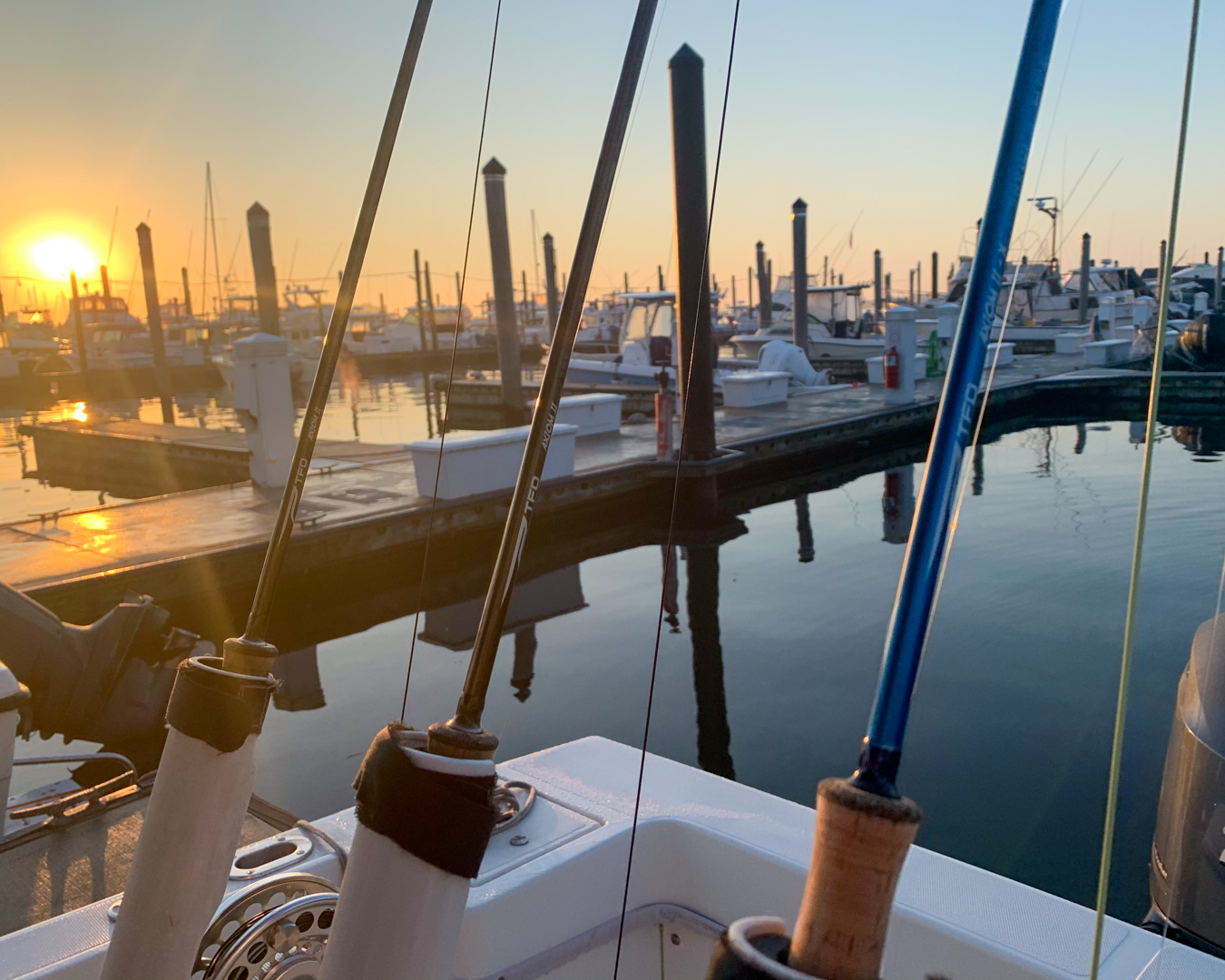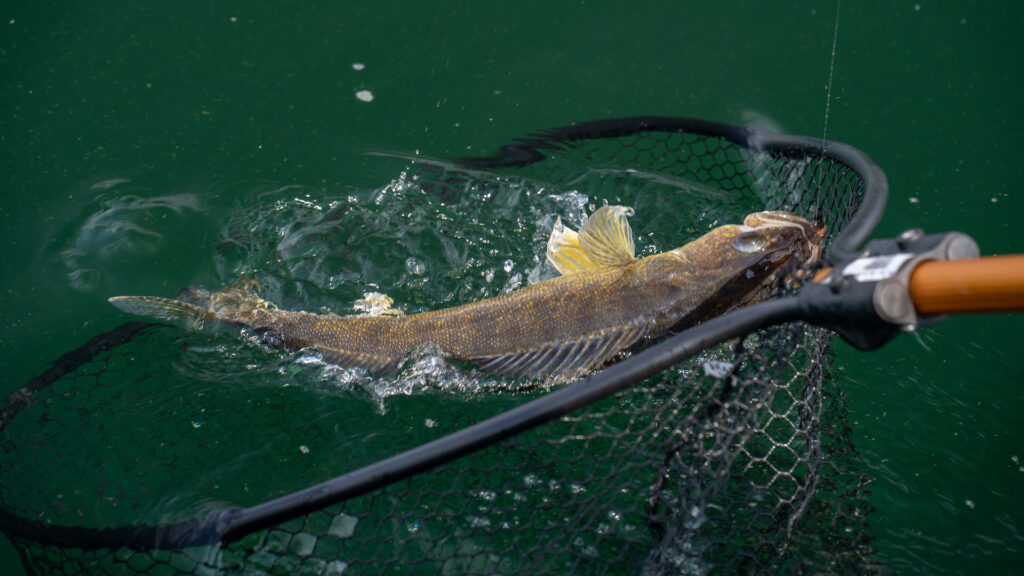As the warmer days of late March approach, ocean and bay water temperatures will begin to rise. Bait fish such as menhaden (bunker to me), herring, silver sides, and anchovies, will set up and attract huge schools of striped bass into the Raritan Bay area. This body of water is shared between New York City, and the New Jersey Bay shore. It is arguably the best spring striped bass fishery on the East coast. I usually look for water temperatures to rise between 47-50 degrees to begin my guiding season. This seems to be the magic temperature where stripers start getting more aggressive on flies and artificial baits.

Striped bass on the Axiom ll-X. // Photo: Joe Maz Mustari
As April creeps in, there will be plenty of opportunities to catch fish of all sizes on the fly and if you are willing to change up a few things, maybe even that trophy bass. Anglers should be prepared by familiarizing themselves with heavy sinking lines. You can surely catch fish with floating or intermediate lines, but hands down a fast-sinking line is the most effective for catching trophy stripers, in fast currents and deep water.
Rods/Lines
You will need rods from an 8wt to 10 wt to cover most situations. My favorites are the TFO Axiom ll or Axiom ll-X.
Most of my clients prefer the Axiom ll, for its ease and adaptability for most casting styles and its ability to launch heavy sink tip lines.  Others like to use the Axiom ll-X for its faster action and stiff butt section for making fast work on the big bass.
Others like to use the Axiom ll-X for its faster action and stiff butt section for making fast work on the big bass.
Another favorite that has been popular on the striper scene this past season is the BC Big Fly, which is perfect for casting heavy lines, and those big 8-to-12-inch flies.
 Fly lines range from 300-500 grain or more depending on the situation. The fly lines are integrated lines that are approximately 28-30 feet of sink tip followed by an intermediate running line. Flies range in size from 1/0 Clousers to 8/0 Beast Flies, or Game Changers.
Fly lines range from 300-500 grain or more depending on the situation. The fly lines are integrated lines that are approximately 28-30 feet of sink tip followed by an intermediate running line. Flies range in size from 1/0 Clousers to 8/0 Beast Flies, or Game Changers.

A fleet of Axiom ll rods and striper flies ready to go. // Photo: Joe Maz Mustari
Angle is Everything
One of the most important things about striper fishing with sinking lines is learning to get the correct angle on your fly line. Stripers use tide and current to their advantage when feeding. The key is to start your drift up tide and up wind of the feeding fish. Then, present your fly in a way, that when retrieved, is coming at you from a 45-degree angle or less from the water’s surface. This angle seems to be the perfect presentation of the fly that stripers love and will result in more bites.
Depending on wind and current, you may have to make a few casts around the boat to find this presentation. Once you discover that sweet spot, it almost feels like the line is tugging back at you. You now are in perfect sync with your fly and will be able to detect even the slightest bite. When done correctly, there will be no slack in your line – which will result in a solid hook set.

Photo: Joe Maz Mustari
The Water Haul
Catching trophy stripers in deep water situations sometimes requires a lot of casts. I recommend my anglers learn the “Water Haul” cast for when we are searching for stripers. To do this, you retrieve the fly until you can see it, almost to the rod tip. Then you make a simple roll cast, and as soon as the line hits the water, pick it up and make a back cast, followed by a sharp haul on the forward cast to shoot all your fly line back out. This is much more efficient than trying to “false” cast a heavy weighted line. Those sinking lines can take a toll on you real fast.

Doubled up on some Raritan Bay striped bass. // Photo: Joe Maz Mustari
Buddy System and the Back Cast
In most shallow water sight casting situations, it is typical that only one angler casts at a time. However, in deeper water, I will have 2 anglers and sometimes 3 casting at once. One thing I think people should learn prior to going on a striper trip or any saltwater trip for that matter, is to become efficient at making a back cast. I routinely have 2 anglers casting a sinking line in the same direction. That is the necessary evil for both anglers to get that perfect angle on their fly lines. As I mentioned earlier – angle is everything! Unless there is one righty and one lefty caster, one of those anglers will be required to make a back cast. If you become an effective back caster, I guarantee your catch ratio will go way up!
Although it’s not the precision casting required for clear water fishing or the delicate presentation of a dry fly, learning some of these simple techniques can make all the difference in catching that striper of a lifetime. There’s nothing better for a guide than to hear these words from his angler….” Thank you Cap, that’s my personal best!!”
Blog written by TFO Ambassador Joe “Maz” Mustari. Maz is a saltwater fishing guide that specializes in fly fishing and light tackle fishing for stripers and other species in the New York City and New Jersey areas. Book a trip with him here, and follow along with him on Instagram here.

TFO Ambassador and blog author Joe “Maz” Mustari with a beautiful striped bass caught on the Axiom ll-X







